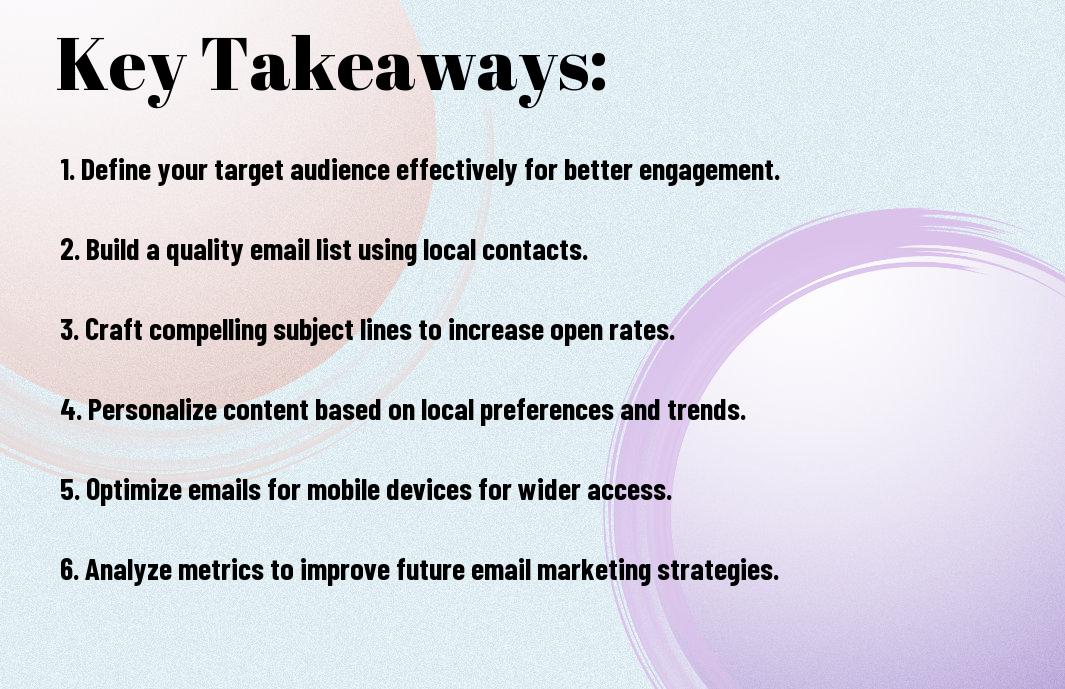Local email marketing can transform your business by creating meaningful connections with your community. By following these five proven steps, you can develop an effective strategy that enhances your outreach, builds your brand, and ultimately drives more customers through your doors. Whether you’re a small business owner or a marketer, these actionable insights will help you craft engaging email campaigns tailored to your local audience. Get ready to boost your customer relationships and grow your local presence with these necessary email marketing techniques.
Key Takeaways:
- Building a targeted email list is crucial for reaching your local audience effectively.
- Personalization in emails increases engagement and makes your communication more relevant to recipients.
- Utilizing local events and promotions in your email content can drive foot traffic and community engagement.
- Email automation tools can enhance efficiency, allowing you to send timely messages based on customer behavior.
- Regularly analyzing your email campaigns helps refine your strategies and improves overall performance.
Understanding Your Local Audience
The key to successful local email marketing lies in understanding your audience. By tailoring your message to resonate with local tastes and preferences, you can enhance engagement and drive conversions. For more insights, check out Email Marketing: 7 Unique Strategies (Backed by Research) which provides valuable strategies to fine-tune your approach.
Identifying Target Demographics
Beside understanding your audience’s preferences, it’s imperative to identify their demographics, such as age, gender, and income level. This information helps you create targeted content that speaks directly to their interests and needs. By segmenting your email list according to these demographic factors, you can send more personalized and impactful messages that resonate with each group.
Analyzing Local Market Trends
To effectively connect with your audience, it’s important to analyze local market trends. By keeping a pulse on what’s popular in your area, you can adapt your email campaigns to incorporate relevant topics, promotions, or events that capture your audience’s attention. This not only boosts engagement but also demonstrates your awareness of local culture and consumer behavior.
Considering local market trends involves researching local events, seasonal promotions, and shifts in consumer preferences. This practice helps you stay ahead of the competition and allows you to adjust your marketing strategy based on real-time data. By regularly evaluating these trends, you can ensure that your email content remains fresh, relevant, and appealing to your audience. Tailoring your messaging around these insights can significantly improve your campaign’s effectiveness.


Building a Quality Email List
Any successful local email marketing strategy begins with a quality email list. By targeting the right individuals and gathering their information, you create a foundation for effective communication. Focus on attracting subscribers who genuinely want to engage with your brand, as this will enhance your campaign’s overall effectiveness. Building a solid email list not only helps in delivering personalized content but also boosts customer loyalty and retention in the long run.
Effective Sign-Up Strategies
Attracting subscribers requires innovative sign-up strategies that incentivize individuals to share their email addresses. You can implement pop-up forms on your website, offer exclusive discounts or free resources, and promote sign-up opportunities on social media. Ensuring that your sign-up process is simple and user-friendly will maximize the chances of potential subscribers joining your list. Additionally, always make sure to communicate the benefits of joining your email list clearly.
Importance of Segmentation
Effective segmentation helps you tailor your marketing messages to specific groups within your email list. By categorizing subscribers based on their interests, behaviors, or demographics, you can deliver more relevant content and offers, leading to higher engagement rates and conversions.
Hence, when you segment your list, you allow for more targeted campaigns that resonate with subscribers on a personal level. This not only improves your open and click-through rates but also fosters stronger relationships with your audience. Segmenting your list based on criteria such as purchase history, location, or engagement levels ensures that your emails are timely and valuable, ultimately driving better results for your local marketing efforts.

Crafting Compelling Email Content
After you have established your email list, the next step is to craft compelling content that resonates with your audience. Your email should provide value, whether through informative articles, special offers, or community news. Focus on engaging your subscribers by creating visually appealing layouts and clear calls to action. The goal is to not only get your emails opened but also to encourage your readers to engage with your content and take the desired actions.
Engaging Subject Lines
Subject lines are the first impression your email makes, and they play a vital role in whether your recipients will open your message. Create concise, attention-grabbing subject lines that entice readers to learn more. Utilize questions, excitement, or a sense of urgency to pique interest and ensure your emails stand out in crowded inboxes.
Personalization Techniques
Across local email marketing, personalization techniques can significantly elevate your content and improve engagement. Tailoring your emails to individual subscribers based on preferences, past purchases, or geographical location can make your messages feel more relevant and engaging. By addressing your readers by name or sending them content that suits their interests, you show that you value them as individuals rather than just another entry on your list.
Email personalization goes beyond just inserting names; it involves understanding your audience’s behavior and preferences. You can segment your list based on shopping habits, locations, or interests, allowing you to send targeted content that meets their needs. Additionally, consider timing your emails to coincide with local events or promotions that might interest specific segments of your audience. The more tailored your content, the higher the likelihood of your subscribers taking action.
Timing and Frequency of Emails
Unlike other marketing strategies, local email marketing relies heavily on timing and frequency to engage your audience effectively. Understanding when to send your emails can dramatically impact open rates and conversions. You want to ensure that you’re not overwhelming your recipients while still staying relevant in their minds, so finding the right balance is key to achieving successful results.
Best Times to Send Emails
Between Tuesday and Thursday, you’ll find the highest engagement rates for your emails. Research shows that audiences are more receptive to marketing messages during the midweek, as weekends are often busy and Mondays can be overwhelming. Sending your emails at optimal times—such as mid-morning or early afternoon—can further enhance your open and click-through rates.
Maintaining Consistent Communication
An effective local email marketing strategy includes maintaining a consistent communication schedule. Regularly sending emails keeps your audience engaged and informed about your brand, products, and promotions.
Emails that are sent consistently help you establish a trustworthy relationship with your audience. Whether it’s weekly updates, monthly newsletters, or seasonal promotions, consistency keeps your business top of mind. This doesn’t mean you should inundate your subscribers; rather, find a rhythm—like biweekly or monthly emails—that works best for your audience. This way, they’ll look forward to your updates and remain engaged with your brand over the long term.
Analyzing and Optimizing Campaign Performance
All successful email marketing campaigns require ongoing analysis and optimization. By examining how your emails perform, you can identify trends and make data-driven decisions that enhance your local marketing efforts. Regularly reviewing your campaigns allows you to fine-tune your messaging, target audience, and overall strategies, ensuring better engagement and higher conversion rates over time.
Key Metrics to Track
Any effective email marketing strategy hinges on tracking key metrics that reveal your campaign’s success. Focus on metrics such as open rates, click-through rates, conversion rates, and unsubscribe rates. By monitoring these figures, you can gain insights into what resonates with your audience and make informed adjustments to improve your campaigns going forward.
A/B Testing Strategies
Analyzing your email marketing performance can be significantly boosted through A/B testing strategies. This method involves creating two different versions of your email to see which performs better among your audience. You could experiment with varying subject lines, content layout, or calls to action, allowing you to pinpoint the elements that yield the best results.
Performance metrics from A/B testing not only show you what works but also help you understand the preferences of your audience. As you gather data, iterate on your campaigns to optimize them continually. Even small tweaks can result in substantial improvements in engagement and conversion rates. Embracing this testing mindset enables you to stay adaptable and responsive to your audience’s needs.
Leveraging Local Partnerships
Your brand can significantly enhance its email marketing efforts by leveraging local partnerships. Collaborating with local businesses, community organizations, or influencers can expand your reach and strengthen your brand’s presence within the community. By creating synergies, you can share resources, create co-branded campaigns, and tap into each other’s audience, thereby maximizing engagement and driving more foot traffic to your establishment.
Collaborating with Local Businesses
Beside directly increasing your audience, partnering with local businesses allows you to co-create special offers that appeal to both customer bases. Joint promotions, cross-promotions, or co-hosted events can deliver fresh content to your email list while showcasing the community spirit. This alignment not only enhances customer loyalty but also opens the door to potential referrals.
Community Engagement Strategies
Between formal partnerships, you can engage your community through local events, sponsorships, or community initiatives that resonate with your audience. Consider organizing workshops or charity drives that encourage participation and foster connections among local residents. Incorporating these initiatives into your email marketing will demonstrate your commitment to the community and increase brand awareness at the same time.
Businesses should prioritize community engagement strategies as a key part of their email marketing plan. Hosting local events, participating in festivals, or collaborating with non-profits can make your brand more visible and approachable. Share stories or highlights of these activities in your emails to foster a sense of community belonging among your subscribers. This approach not only builds a positive brand image but also helps you nurture relationships that can lead to higher customer loyalty and repeat business.
Final Words
Presently, implementing the five proven steps for local email marketing can significantly enhance your outreach and engagement. By building a targeted mailing list, creating compelling content, personalizing your messages, optimizing for mobile, and analyzing your results, you position your business for success. Each step empowers you to connect effectively with your local audience, fostering loyalty and driving sales. As you embrace these strategies, you’ll refine your approach and continue to grow your customer base.
FAQ
Q: What is local email marketing?
A: Local email marketing refers to targeted email campaigns that are designed to engage customers within a specific geographical area. It focuses on sending promotions, event information, and localized content to nurture relationships and drive foot traffic to local businesses.
Q: Why is local email marketing important?
A: Local email marketing is vital because it allows businesses to directly connect with their community. It enhances customer loyalty, increases brand awareness, and can lead to higher conversion rates by delivering tailored messages to the right audience.
Q: What are the first steps in building a local email marketing list?
A: The initial steps include collecting email addresses through in-store sign-ups, website subscriptions, and social media promotions. It’s important to provide incentives, such as discounts or exclusive offers, to encourage customers to join your email list.
Q: How can I segment my email list for local marketing?
A: Segmentation can be achieved by categorizing your email list based on criteria such as geographical location, purchasing behavior, or engagement level. This allows you to send more personalized and relevant content that resonates with different segments of your audience.
Q: What type of content works best in local email marketing campaigns?
A: Effective content for local email marketing includes local events, exclusive promotions, community news, and personalized recommendations based on customer behavior. Highlighting nearby collaborations or partnerships can also enhance relevance and engagement.
Q: How can I measure the success of my local email marketing efforts?
A: Success can be measured through various metrics such as open rates, click-through rates, conversion rates, and customer feedback. Tracking these metrics will provide insights into what is resonating with your audience and where improvements can be made.
Q: How often should I send local emails to my audience?
A: The frequency of local emails should be balanced to ensure you remain top-of-mind without overwhelming your audience. Generally, sending emails once or twice a month can be effective, with special emails for timely promotions or events as needed.



